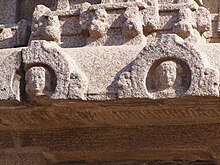Ganesha Ratha
| Ganesha Ratha | |
|---|---|
Mahabalipuram | |
| State | Tamil Nadu |
| Country | India |
| Architecture | |
| Creator | Mamalla |
| Completed | c. 650 |
Ganesha Ratha is a
Geography
The temple is located in Mamallapuram, now known as Mahabalipuram,
History

The Ganesha Ratha is a fully completed rock-cut structure, while nearby rathas are incomplete.[4] The current stone ratha is a replica of a wooden version which preceded it.[5][6] Its construction is credited to Narasimhavarman I who reigned 630-668AD.[7] While it is conjectured that this ratha was built prior to the other rathas of the area, there is no historical evidence to confirm it.
The temple was originally dedicated to Shiva but in the 1880s, villagers replaced the Shiva Linga with an image of Ganesha, after formally seeking permission from the District Collector, and may have been attributed to King George V of the United Kingdom.[8] The original Shiva Linga is installed under a tree nearby.[4] Along with several other monuments, this temple gained UNESCO World Heritage Site distinction in 1984 as "Group of Monuments at Mahabalipuram".[1]
Architecture
Layout

It is built to a rectangular plan which measures 20 by 11.5 feet (6.1 m × 3.5 m), and is 28 feet (8.5 m) in height on the exterior. The interior rectangular chamber measures 7 by 4 feet (2.1 m × 1.2 m), and is 7 feet (2.1 m) in height. The ratha is three tiered and studded with images and other architectural features which are found in other
Features
There are 18 inscriptions in
References
- ^ a b c "Group of Monuments at Mahabalipuram". UNESCO. Retrieved 8 February 2007.
- ISBN 978-1-884964-04-6. Retrieved 3 January 2013.
- ^ "Arjuna's Penance". Retrieved 30 December 2012.
- ^ a b c d e f g "Mahabalipuram – The Workshop of Pallavas – Part III". 6. Ganesha Ratha. Indian History and Architecture, Puratattva.in. Archived from the original on 25 December 2013. Retrieved 20 February 2013.
- ^ "Pancha Rathas, Mamallapuram". Archaeological Survey of India. Retrieved 23 October 2012.
- ISBN 978-1-85669-371-4. Retrieved 9 January 2013.
- ^ ISBN 978-0-87586-484-6. Retrieved 7 February 2013.
- ISBN 978-1-4093-6215-9. Retrieved 23 February 2013.
- ^ a b "Ganesha ratha, Mamallapuram". Online Gallery of British Library. Retrieved 23 October 2012.
- ISBN 978-81-206-0571-8. Retrieved 23 February 2013.
- ^ "A monumental effort". Front Line India's National Magazine from the publishers of The Hindu. 8 November 2003. Archived from the original on 10 April 2013. Retrieved 30 December 2012.

